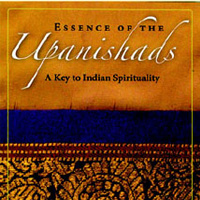ESSENCE OF THE UPANISHADS A Key to Indian Spirituality : Eknath Easwaran
Easwaran takes one of India’s classic wisdom texts, the Katha Upanishad, and explains how it embraces all the key ideas of Indian spirituality within the context of a powerful mythic quest – the story of a young hero who ventures into the land of death in search of immortality. Easwaran shows how the Katha Upanishad can help us understand our lives today Illustrating the insights of the Katha through analogies and everyday examples, Easwaran shows how these ancient teachings help us gain a deeper understanding of our world and ourselves today.
Excerpts Get up! Wake up! Seek the guidance of an Illumined teacher and realize the Self. Sharp like a razor’s edge, the sages say, Is the path, difficult to traverse.
– Katha Upanishad
SOME YEARS AGO I translated what I called the Classics of Indian c: the Upanishads, the Bhagavad Gita, and the Dhammapada. These ancient texts, memorized and passed from generation to generation for hundreds of years before they were written down, represent early chapters in the long, unbroken story of India’s Spiritual experience. The Upanishads, old before the dawn of history; come to us like snapshots of a timeless landscape. The Gita condenses and elaborates on these insights in a dialogue set on & battlefield, as apt a setting now as it was three thousand years ago. And the Dhammapada, a kind of spiritual handbook, distills the practical implications of the same truths presented afresh by the Compassionate Buddha around 500 BC.
These translations proved surprisingly popular; perhaps because they were intended not so much to be literal or literary as to bring out the meaning of these documents for us today. For it is here that these classics come to life. They are not dry texts ; they speak to us. Each is the opening voice of a conversation which we are invited to join – a voice that experts a reply. So in India we say that the meaning of the scriptures is only complete when this call is answered in the lives of men and women like you and me. Only then do we see what the scriptures mean here and now. G. K. Chesterton once said that to understand the Gospels, we have only to look at Saint Francis of Assisi. Similarly, I would say, to grasp the meaning of the Bhagavad Gita, we need look no farther than Mahatma Gandhi, who made it a guide for every aspect of daily living. Wisdom may be perennial, but to see its relevance we must see it lived out.
In India, this process of assimilating the learning of the head into the wisdom of the heart is said to have three stages: shravanam, mananam, and nididhyasanam; roughly, hearing, reflection, and meditation. These steps can merge naturally into a single daily activity, but they can also be steps in a journey that unfolds over years. Often this journey is begun in response to a crisis. In my own case, though I must have heard the scriptures many times as a child, I don’t remember them making any deep impression. When I discovered the Bhagavad Gita, I was attracted by the beauty of its poetry. I didn’t understand its teachings at all. It was not until I reached a crisis of meaning in my mid-thirties, when outward success failed to fill the longing in my heart, that I turned to these classics for wisdom rather than literary beauty. Only then did I see that I had been, as the Buddha puts it, like a spoon that doesn’t know the taste of the soup.
Since that time I have dedicated myself to translating these scriptures into daily living through the practice of meditation. The book in your hands is one fruit of this long endeavor. Such a presentation can only be intensely personal. In my translations I naturally let the texts speak for themselves; here I make no attempt to hide the passion that gave those translations their appeal. To capture the essence of the Gita, the Upanishads, and the Dhammapada, I offer what I have learned personally from trying to live them out in a complex, hurried world. I write not as a scholar, but as an explorer back from a long, long voyage eager to tell what he has found.
Yet however personal the exploration, these discoveries are universal.
So it is not surprising that at the heart of each of these classics lies a myth – variations on the ageold story of a hero in quest of wisdom that will redeem the world. In the Upanishads, a teenager goes to the King of Death to find the secret of immortality. In the Gita, standing between opposing armies on the eve of Armageddon, the warrior prince Arjuna seeks guidance from an immortal teacher, Sri Krishna.
And behind the Dhammapada lies the story of the Buddha himself, a true story woven into legend: a prince who forsakes his throne to find a way for all the world to go beyond sorrow in this life. These old stories are our own, as relevant today as ever. Myth always involves the listener. We identify with its heroes; their crises mirror ours. Their stories remind us not only what the






























